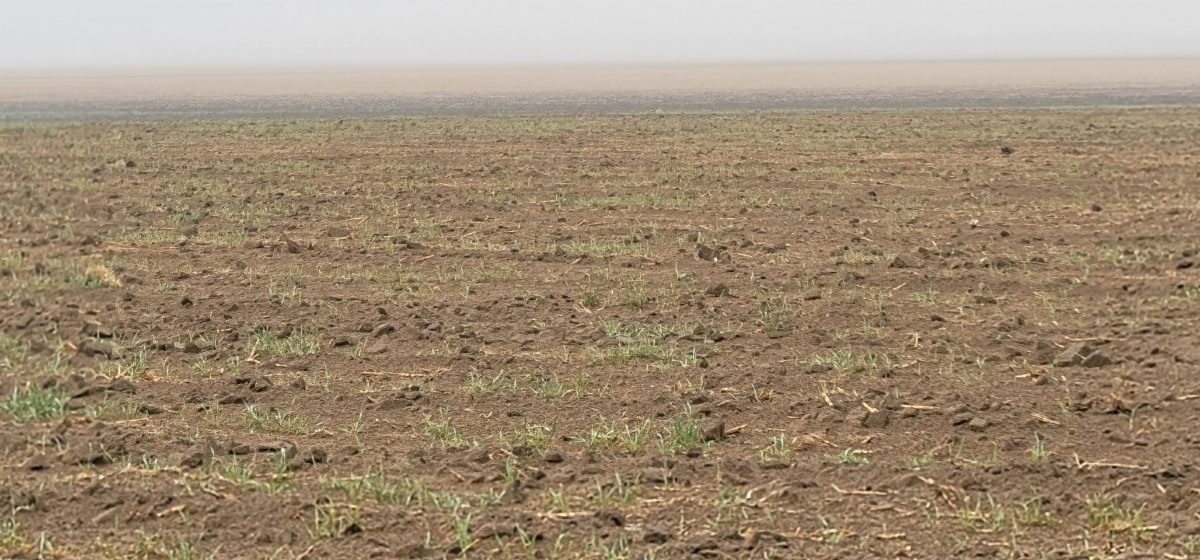Wheat farmers are, by nature, optimistic, but that optimism is starting to wane in southwest Kansas, where much of the wheat that was drilled last fall has yet to emerge.
Only 19% of the Kansas wheat crop is currently rated in good to excellent condition, with another 52% rated poor to very poor, according to the USDA’s National Agricultural Statistics Service. According to the March 27 report, 77% of subsoil moisture supplies are rated short to very short.
“We’re eating through subsoil moisture,” said Tyler Ediger who farms near Meade, Kansas. “We need a slow inch to inch and a half of moisture.”
Average annual precipitation for the area is 23 inches, but over the past year, they’ve received roughly half that.
Still, Ediger says they’re better off than most in the area, having received a half inch a couple weeks ago. Their fields have a stand, so they’re not blowing yet, but winds have been strong and sustained for much of the area.
North of Lakin in Kearny County, Gary Millershaski’s fields aren’t faring as well. An area that typically gets 18.8” of annual precipitation, they’ve only received 8.6” over the past 365 days. While last year’s crop was also raised in drought conditions, it had the benefit of some subsoil moisture, which has all but been depleted by now. Even the residue left from last year’s crop has been reduced by wind and drought.
“We’re totally out of residue,” Millershaski said. “There’s nothing out there.”
He said insurance adjusters will be in the area over the next couple weeks. Many of the fields that haven’t even emerged will be adjusted out, giving farmers like Millershaski few options for ways to protect the blowing soil.
“I’m not going to chase another crop in dry soil,” he said. “Right now, it’s all about getting by and spending the least amount possible.”
In Sheridan County, Brett Oelke’s fields are surviving on half their average precipitation over the past two years as well.
“We’re pretty fortunate right now,” he said, because the moisture on this wheat crop has come with a timely three-quarters of an inch of rain in October when it was drilled and another inch and a half of moisture from snow since January.
Oelke’s moisture probe proved that even though his area has gotten some timely moisture, the crop is far from trouble. Reaching only two feet down, he said last year’s subsoil moisture was four feet.
“We’re 22 to 24 inches behind over the past few years,” he said.
In the sandy soils of Barber County, farmers are also dealing with less than half their average moisture.
“We need a rain really bad — and soon,” Chris Boyd said.
The wheat plants are small and don’t have many tillers. Fields in the Isabel area have received only one inch of rain total since the crop was planted.
In addition to fields that have been blown out completely from strong winds, they are also dealing with winter grain mites and army cut worms, which will limit yield potential. These pests can be controlled by applying an insecticide or pesticide, an added expense for a crop without a lot of potential.
“We were blessed with a nice harvest last year, but that crop used all of the subsoil moisture,” Boyd said. “With virtually no moisture on this current crop and nothing in the forecast, producers are faced with difficult decisions on how many more inputs — such as insecticide for grain mites — to invest on a potential crop failure.”
Rain is critical right now as temperatures begin to warm up and the wheat crop comes out of dormancy.
“We’ll take whatever moisture we can get,” said Millershaski.
With hit and miss showers mostly avoiding southwest Kansas this past week and few scattered showers forecast in the next ten days, farmers remain hopeful for additional timely rains.
“We’ll stay optimistic,” Ediger said.



